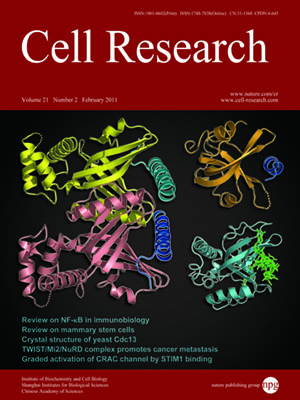
Volume 21, No 2, Feb 2011
ISSN: 1001-0602
EISSN: 1748-7838 2018
impact factor 17.848*
(Clarivate Analytics, 2019)
Volume 21 Issue 2, February 2011: 338-349
ORIGINAL ARTICLES
Pulse labeling and long-term tracing of newborn neurons in the adult subgranular zone
Xuewen Cheng1, Yang Li1, Ying Huang1, Xiaoyan Feng1, Guoping Feng2 and Zhi-Qi Xiong1
1Institute of Neuroscience, National Key Laboratory of Neuroscience, Shanghai Institutes for Biological Sciences, Chinese Academy of Sciences, 320 Yueyang Road, Shanghai 200031, China
2Department of Brain and Cognitive Sciences, McGovern Institute, Massachusetts Institute of Technology, 77 Massachusetts Avenue, Cambridge, MA 02139, USA
Correspondence: Zhi-Qi Xiong,(xiongzhiqi@ion.ac.cn)
Research over the past decades has demonstrated that adult brain produces neural progenitor cells which proliferate and differentiate to newborn neurons that integrate into the existing circuit. However, detailed differentiation processes and underlying mechanisms of newly generated neurons are largely unknown due to the limitation of available methods for labeling and manipulating neural progenitor cells and newborn neurons. In this study, we designed a tightly controlled, noninvasive system based on Cre
/loxP recombination to achieve long-term tracing and genetic manipulation of adult neurons
in vivo. In this system, tamoxifen-inducible recombinase, CreER
T2, was driven by BAC-based promoter of doublecortin (DCX, a marker of newborn neurons). By crossing this Cre line with reporter mouse, we found that newborn neurons in the dentate gyrus (DG) could be selectively pulse-labeled by tamoxifen-induced expression of yellow fluorescent protein (YFP). YFP-positive neurons were identified by coimmunostaining with cell type-specific markers and characterized by electrophysiological recording. Furthermore, analysis of the migration of these neurons showed that the majority of these labeled neurons migrated to the inner part of granule cell layer. Moreover, spine growth of inner molecular layer of newborn granule neurons takes a dynamic pattern of invert U-shape, in contrast to the wedge-shaped change in the outer molecular layer. Our transgenic tool provides an efficient way to selectively label and manipulate newborn neuron in adult mouse DG.
Cell Research (2011) 21: 338-349. doi:10.1038/cr.2010.141; published online 12 October 2010
FULL TEXT | PDF
Browse 2246


